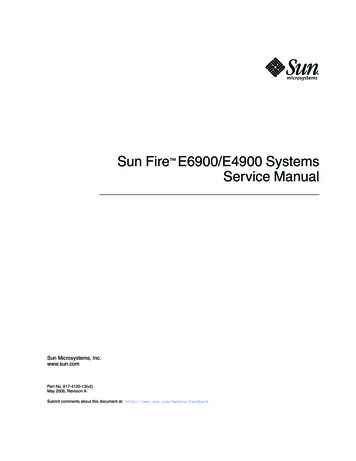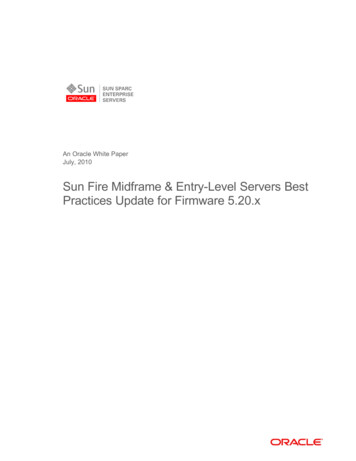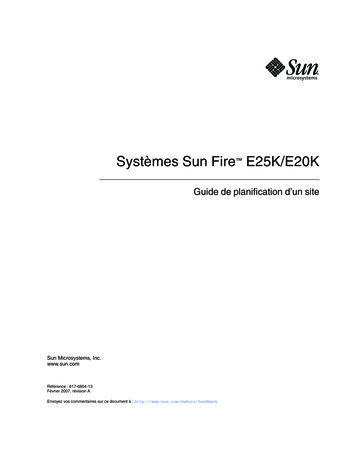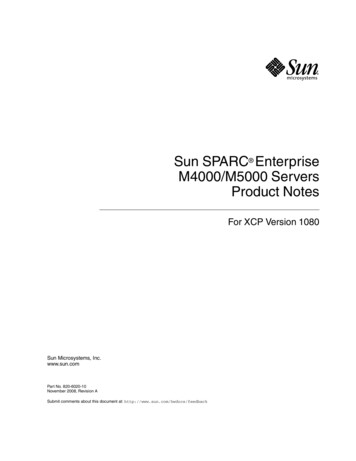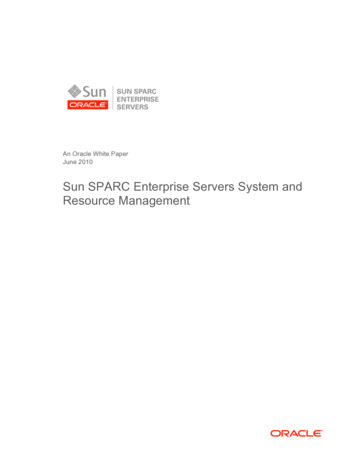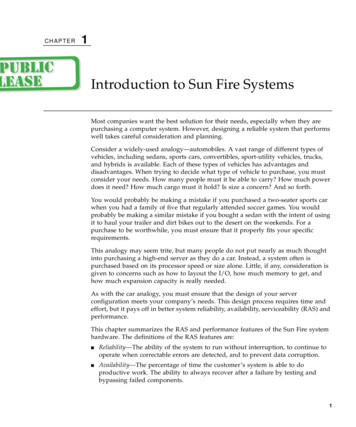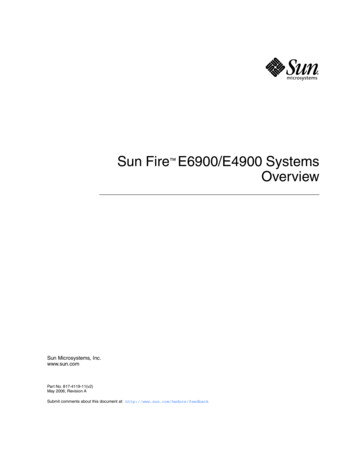
Transcription
Sun Fire E6900/E4900 SystemsOverviewSun Microsystems, Inc.www.sun.comPart No. 817-4119-11(v2)May 2006, Revision ASubmit comments about this document at: http://www.sun.com/hwdocs/feedback
Copyright 2006 Sun Microsystems, Inc., 4150 Network Circle, Santa Clara, California 95054, U.S.A. All rights reserved.Sun Microsystems, Inc. has intellectual property rights relating to technology that is described in this document. In particular, and withoutlimitation, these intellectual property rights may include one or more of the U.S. patents listed at http://www.sun.com/patents and one ormore additional patents or pending patent applications in the U.S. and in other countries.This document and the product to which it pertains are distributed under licenses restricting their use, copying, distribution, anddecompilation. No part of the product or of this document may be reproduced in any form by any means without prior written authorization ofSun and its licensors, if any.Third-party software, including font technology, is copyrighted and licensed from Sun suppliers.Parts of the product may be derived from Berkeley BSD systems, licensed from the University of California. UNIX is a registered trademark inthe U.S. and in other countries, exclusively licensed through X/Open Company, Ltd.Sun, Sun Microsystems, the Sun logo, Java, AnswerBook2, docs.sun.com, Sun Fire, and Solaris are trademarks or registered trademarks of SunMicrosystems, Inc. in the U.S. and in other countries.All SPARC trademarks are used under license and are trademarks or registered trademarks of SPARC International, Inc. in the U.S. and in othercountries. Products bearing SPARC trademarks are based upon an architecture developed by Sun Microsystems, Inc.The OPEN LOOK and Sun Graphical User Interface was developed by Sun Microsystems, Inc. for its users and licensees. Sun acknowledgesthe pioneering efforts of Xerox in researching and developing the concept of visual or graphical user interfaces for the computer industry. Sunholds a non-exclusive license from Xerox to the Xerox Graphical User Interface, which license also covers Sun’s licensees who implement OPENLOOK GUIs and otherwise comply with Sun’s written license agreements.U.S. Government Rights—Commercial use. Government users are subject to the Sun Microsystems, Inc. standard license agreement andapplicable provisions of the FAR and its supplements.DOCUMENTATION IS PROVIDED "AS IS" AND ALL EXPRESS OR IMPLIED CONDITIONS, REPRESENTATIONS AND WARRANTIES,INCLUDING ANY IMPLIED WARRANTY OF MERCHANTABILITY, FITNESS FOR A PARTICULAR PURPOSE OR NON-INFRINGEMENT,ARE DISCLAIMED, EXCEPT TO THE EXTENT THAT SUCH DISCLAIMERS ARE HELD TO BE LEGALLY INVALID.Copyright 2006 Sun Microsystems, Inc., 4150 Network Circle, Santa Clara, Californie 95054, États-Unis. Tous droits réservés.Sun Microsystems, Inc. possède les droits de propriété intellectuels relatifs à la technologie décrite dans ce document. En particulier, et sanslimitation, ces droits de propriété intellectuels peuvent inclure un ou plusieurs des brevets américains listés sur le sitehttp://www.sun.com/patents, un ou les plusieurs brevets supplémentaires ainsi que les demandes de brevet en attente aux les États-Unis etdans d’autres pays.Ce document et le produit auquel il se rapporte sont protégés par un copyright et distribués sous licences, celles-ci en restreignent l’utilisation,la copie, la distribution, et la décompilation. Aucune partie de ce produit ou document ne peut être reproduite sous aucune forme, par quelquemoyen que ce soit, sans l’autorisation préalable et écrite de Sun et de ses bailleurs de licence, s’il y en a.Tout logiciel tiers, sa technologie relative aux polices de caractères, comprise, est protégé par un copyright et licencié par des fournisseurs deSun.Des parties de ce produit peuvent dériver des systèmes Berkeley BSD licenciés par l’Université de Californie. UNIX est une marque déposéeaux États-Unis et dans d’autres pays, licenciée exclusivement par X/Open Company, Ltd.Sun, Sun Microsystems, le logo Sun, Java, AnswerBook2, docs.sun.com, Sun Fire, et Solaris sont des marques de fabrique ou des marquesdéposées de Sun Microsystems, Inc. aux États-Unis et dans d’autres pays.Toutes les marques SPARC sont utilisées sous licence et sont des marques de fabrique ou des marques déposées de SPARC International, Inc.aux États-Unis et dans d’autres pays. Les produits portant les marques SPARC sont basés sur une architecture développée par SunMicrosystems, Inc.L’interface utilisateur graphique OPEN LOOK et Sun a été développée par Sun Microsystems, Inc. pour ses utilisateurs et licenciés. Sunreconnaît les efforts de pionniers de Xerox dans la recherche et le développement du concept des interfaces utilisateur visuelles ou graphiquespour l’industrie informatique. Sun détient une license non exclusive de Xerox sur l’interface utilisateur graphique Xerox, cette licence couvrantégalement les licenciés de Sun implémentant les interfaces utilisateur graphiques OPEN LOOK et se conforment en outre aux licences écrites deSun.LA DOCUMENTATION EST FOURNIE "EN L’ÉTAT" ET TOUTES AUTRES CONDITIONS, DÉCLARATIONS ET GARANTIES EXPRESSESOU TACITES SONT FORMELLEMENT EXCLUES DANS LA LIMITE DE LA LOI APPLICABLE, Y COMPRIS NOTAMMENT TOUTEGARANTIE IMPLICITE RELATIVE À LA QUALITÉ MARCHANDE, À L’APTITUDE À UNE UTILISATION PARTICULIÈRE OU ÀL’ABSENCE DE CONTREFAÇON.PleaseRecycle
ContentsPreface1.2.xiSun Fire Product Overview1–11.1Standard Features1–11.2Machine Configurations1–31.2.1Sun Fire E6900 System1–31.2.2Sun Fire E4900 System1–6System Features and Capabilities2.12.2Partitions and 2–12–22–32–42.2.1Reducing the Probability of Error2.2.2Correcting Errors Using Error-Correcting Code2.2.2.12.2.32–42–4Error-Correcting Code Protection of the DataInterconnect 2–5Detecting Uncorrectable Errors2–52.2.3.1Multiple-Bit Data Errors2.2.3.2Address Errors2.2.3.3System Timeout Errors2–52–52–6iii
2.2.3.42.2.42.32.2.4.1Temperature2–62.2.4.2Power Subsystem2–62–7Availability Goals for the Sun Fire System2.3.2High Availability Capabilities of the Sun Fire System2.3.2.1Cooling2.3.2.2AC Power ency Capabilities2–82.3.3.1DC Power2.3.3.2Logic 2–9Redundant ComponentsServiceability ntal SensingAvailability2.3.32.4Power Corrected Failures2–102–10Mechanical Serviceability2–112.4.1.1DC Power Supply Removal and Replacement2.4.1.2Fan Tray Removal and Replacement2.4.1.3Domain Isolation2.4.2Nonconcurrent Service2.4.3Remote ServiceHardware Overview2–123–13.1Standard Operation3–13.2Data Interconnect3.3Console Bus Interconnect3–3Sun Fire E6900/E4900 Systems Overview May 20063–42–112–112–112–11
4.Sun Fire System Components4.1CPU/Memory Board4.2I/O Assemblies4.2.14–14–14–1PCI/PCI /PCI-X I/O4–24.3Repeater Board4.4System Controller Board, Version 2 With Enhanced MemoryIndex4–24.4.1Redundant System Controllers4.4.2Virtual Domain Key Switches4.4.3Solaris Console4.4.4Virtual Time Of Day4.4.5Environmental ontentsv
viSun Fire E6900/E4900 Systems Overview May 2006
FiguresFIGURE 1-1SunFire Systems and Sun Fire Cabinet 2FIGURE 1-2SunFire 6800 System Cabinet—Front and Rear Views 5FIGURE 1-3SunFire 4810 System Mounted in Optional Sun Fire Cabinet—Front and RearViews 7FIGURE 1-4SunFire 4800 System—Front and Rear Views 9FIGURE 1-5Sun Fire 3800 System Mounted in Optional Sun Fire Cabinet—Front and RearViews 112FIGURE 2-1Partitionsand Domains on a Sun Fire 6800 SystemFIGURE 3-1StandardOperation of the Sun Fire 6800/4810/4800/3800 Systems 2vii
viiiSun Fire E6900/E4900 Systems Overview May 2006
TablesTABLE 1-1SunFire Shared Components 3TABLE 1-2SunFire 6800 System Features 4TABLE 1-3SunFire 4810 System Features 6TABLE 1-4SunFire 4800 System Features 8TABLE 1-5SunFire 3800 System Features 10ix
xSun Fire E6900/E4900 Systems Overview May 2006
PrefaceThis document provides the following information about the Sun Fire E6900/E4900 systems: Machine configurations of the Sun Fire E6900/E4900 systemsHardware overviewSystem componentsReliability, availability, and serviceability featuresHow This Document Is OrganizedThis book is organized into four chapters:Chapter 1 provides an overview of the Sun Fire E6900/E4900 systems.Chapter 2 provides information on the system features and capabilities.Chapter 3 provides a hardware overview.Chapter 4 provides information on the Sun Fire system components.Related DocumentationThe documents listed as online are available e/docs/xi
ApplicationTitleInstallationSun Fire E6900/E4900 Systems Installation GuideOperationSun Fire Cabinet Installation and Reference GuideSun Fire E6900/E4900 Systems Getting StartedSun Fire E6900/E4900 Systems Service ManualDocumentation, Support, and TrainingSun ttp://www.sun.com/training/Third-Party Web SitesSun is not responsible for the availability of third-party web sites mentioned in thisdocument. Sun does not endorse and is not responsible or liable for any content,advertising, products, or other materials that are available on or through such sitesor resources. Sun will not be responsible or liable for any actual or alleged damageor loss caused by or in connection with the use of or reliance on any such content,goods, or services that are available on or through such sites or resources.xiiSun Fire E6900/E4900 Systems Overview May 2006
Sun Welcomes Your CommentsSun is interested in improving its documentation and welcomes your comments andsuggestions. You can submit your comments by going to:http://www.sun.com/hwdocs/feedbackPlease include the title and part number of your document with your feedback:Sun Fire E6900/E4900 Systems Overview, part number 817-4119-11(v2)Prefacexiii
xivSun Fire E6900/E4900 Systems Overview May 2006
CHAPTER1Sun Fire Product OverviewThis chapter discusses the features and capacity of the Sun Fire E6900 and Sun FireE4900 systems.This family of servers provides entry-level to high-end server functionality. The SunFire E6900 system has spac e for internal peripherals mounted within the 19-inchcabinet. You have the flexibility with the remaining system to install it in industrystandard 19-inch cabinets or have it preinstalled in a Sun Fire system cabinet. TheSun Fire system cabinet can hold one Sun Fire E4900 system.1.1Standard FeaturesThe standard features of these systems include: Rackmountable in industry standard 19-inch rack (Sun Fire E4900)Support for up to 24 CPUsSupport for up to 32 PCI/PCI /PCI-X I/O slotsExtensive redundancySystem controllersSupport for multiple domainsConcurrent hardware maintenanceCommon componentsRedundant power and cooling9.6-Gbyte bus bandwidth1-1
Sun Fire E6900 systemSun Fire cabinetSun Fire E4900 system(skinless)FIGURE 1-11-2Sun Fire Systems and Sun Fire CabinetSun Fire E6900/E4900 Systems Overview May 2006
The Sun Fire E6900 and E4900 systems share the following components: 1.2CPU/Memory boardCPU processorsMemory DIMMsPCI/PCI /PCI-X I/O assemblyPCI I/O cardsSystem Controller board (version 2 with enhanced memory)Repeater boardMachine ConfigurationsTwo machine configurations are available: 1.2.1Sun Fire E6900 systemSun Fire E4900 rackmountable systemSun Fire E6900 SystemThe Sun Fire E6900 system has support for six CPU/Memory boards, four I/Oassemblies, four Repeater boards, and two System Controller boards. Although thereare four Repeater boards, they are logically two redundant repeaters (two boardstogether make up one logical repeater). FIGURE 1-2 shows front and rear views of theSun Fire E6900 system cabinet. TABLE 1-1 lists the features of the Sun Fire E6900system.TABLE 1-1Sun Fire E6900 System FeaturesFeaturesQuantity or DescriptionCPU/Memory boards6CPUs24Maximum memory192 DIMM socketsI/O assemblies4 (PCI/PCI /PCI-X)System Controller boards(version 2)2Repeater boards4Domains4 maximumPower supplies6Power requirements200–240 VACChapter 1Sun Fire Product Overview1-3
TABLE 1-11-4Sun Fire E6900 System FeaturesFeaturesQuantity or DescriptionRedundant coolingYesRedundant AC inputYesInternal peripheralsNone (However, space is available in thecabinet for peripherals options.)PackagingSun Fire E6900 cabinetSun Fire E6900/E4900 Systems Overview May 2006
RearFront.FIGURE 1-2Sun Fire E6900 System Cabinet—Front and Rear ViewsChapter 1Sun Fire Product Overview1-5
1.2.2Sun Fire E4900 SystemThe Sun Fire E4900 system has support for three CPU/Memory boards, two I/Oassemblies, two Repeater boards, and two System Controller boards. FIGURE 1-3shows front and rear views of the Sun Fire E4900 system. TABLE 1-2 lists the featuresof the Sun Fire E4900 system.TABLE 1-21-6Sun Fire E4900 System FeaturesFeaturesQuantity or DescriptionCPU/Memory boards3CPUs12Maximum memory96 DIMM socketsI/O assemblies2 (PCI/PCI /PCI-X)System Controller boards(version 2)2Repeater boards2Domains2 maximumPower supplies3Power requirements200–240 VACRedundant coolingYesRedundant AC inputNoInternal peripheralsNonePackagingRackmountable, or mounted in a Sun Fire cabinetSun Fire E6900/E4900 Systems Overview May 2006
FrontFIGURE 1-3RearSun Fire E4900 System—Front and Rear ViewsChapter 1Sun Fire Product Overview1-7
1-8Sun Fire E6900/E4900 Systems Overview May 2006
CHAPTER2System Features and CapabilitiesThe Sun Fire E6900/E4900 system’s primary features include the ability to partitionyour system and create domains.These features provide greater reliability,availability, and serviceability, which means uptime. These features and capabilitiesare as follows: Partition—The ability for the system to logically behave as two separate systems Domain—The ability to create logically independent multiple sections within apartition, with each domain running its own operating system Reliability—A function of the care with which the hardware and software designwas executed, the quality of the components selected, and the quality of themanufacturing process (for example, ESD protection, clean rooms, and so forth) Availability—The percentage of time the customer’s system is able to doproductive work Serviceability—The system ensures that repair time (downtime) is kept to aminimum2-1
2.1Partitions and DomainsThe Sun Fire system can be divided into partitions and domains. A single physicalsystem can have multiple independent logical systems, each running its ownoperating system, by using partitions and domains. Partitions and domains differonly in terms of their flexibility and isolation.FIGURE 2-1Partitions and Domains on a Sun Fire E6900 SystemPartitions A and B have separate Repeater boards.Partition ABoard 0Partition BBoard 1Board 2Board 3Board 4Board 5Domain 0Domain 0Partition APartition BA partition can have up to two domains.Partition ABoard 0Partition BBoard 1Board 2Domain 0Board 3Domain 1Partition ABoard 4Board 5Domain 0Partition BActive domain connectionActive domain connectionActive domain connectionInactive logical connection2.1.1PartitionsA single physical Sun Fire E6900 system can be divided into two partitions. Allconnections between boards of one partition and boards of the other partition aredisabled. The system logically behaves as two separate systems.2-2Sun Fire E6900/E4900 Systems Overview May 2006
If the partitions are assigned to the physical half of the Sun Fire E6900 system, thenthe power planes associated with each partition are also isolated. A Sun Fire E6900system can be divided into two partitions by logically isolating one set of Repeaterboards for each partition. Sun Fire E4900 systems also support two partitions.Each partition on the Sun Fire E6900 system can have up to two domains, allowingfor up to four domains total. For the Sun Fire E4900 system, if a single partition isestablished, it can support two domains; if two partitions are established, however,each partition will support only one domain.2.1.2DomainsThe Sun Fire system can be logically divided into multiple domains. Since eachdomain is comprised of one or more system boards, a domain can have between oneand 24 processors. Each domain runs its own instance of the operating system andhas its own peripherals and network connections. You can configure domainswithout interrupting the operation of other domains on the same system.Domains can be used for: Testing new applicationsUpdating the operating systemConfiguring several domains to support separate departmentsWhile production work continues on the remaining (and usually larger) domain,there will not be any adverse interaction between any of the domains. You can gainconfidence in the correctness of applications without disturbing production work.When the testing work is complete, the system can be rejoined logically withoutrebooting (there are no physical changes when you use domains). Thus, if problemsoccur, the rest of your system is not affected.The Sun Fire E6900 system can have up to four domains. The Sun Fire E4900 systemcan have up to two domains. Each instance of the Solaris Operating System runsin its own domain. Domains do not depend on each other and do not interact witheach other.A single partition on a Sun Fire E6900 system can be divided into two domains.Unlike partitions, domains share the Repeater boards. Each domain gets half theaddress bandwidth of a full system bus.Chapter 2System Features and Capabilities2-3
2.2ReliabilityThe reliability capabilities of the Sun Fire system fall into four categories: 2.2.1Reducing the probability of errorsCorrecting errors using error-correcting code (ECC)Detecting uncorrectable errorsSensing environmental factorsReducing the Probability of ErrorAll the ASICs are designed for worst-case temperature, voltage, frequency, andairflow combinations. The high level of logic integration in the ASICs reducescomponent and interconnect count.A distributed power system improves power supply performance and reliability.Extensive self-test upon power-on reboot after a hardware failure screens all of thekey logic blocks in the Sun Fire system: Built-in self-test logic in all the ASICs.The power-on self-test (POST)—controlled from the System Controllerboard—tests each logic block first in isolation, and then with progressively moreof the system. Failing components are electrically isolated from the centerplane.The result is that the system is booted only with logic blocks that have passed thisself-test and that must operate without error.All I/O cables have a positive lock mechanism and a strain-relief support to preventaccidental disconnections.2.2.2Correcting Errors Using Error-Correcting CodeThe Sun Fire system contains a number of subsystems that are capable of recoveringfrom errors without failing. Subsystems that have a large number of connectionshave greater odds of failure. The subsystems that have the highest probability oferrors are protected from transient errors through the use of single-bit errorcorrection that uses an error-correcting code.2-4Sun Fire E6900/E4900 Systems Overview May 2006
2.2.2.1Error-Correcting Code Protection of the Data InterconnectThe entire data path from the local data crossbars and the memory subsystem isprotected by error-correcting code. Single-bit-data errors detected in thesesubsystems are corrected by receiving a UltraSPARC IV/IV module, and thesystem is notified for logging purposes that an error has occurred.The memory subsystem does not check or correct errors but provides the extrastorage bits. The Sun Fire data buffer chips use the error-correcting codes to assist infault isolation.If a correctable error is detected by the interconnect, the system controller is notifiedand enough information is saved to isolate the failure to a single net within theinterconnect system. The data containing the error is sent through the interconnectunchanged, and the error is reported.Memory errors are logged by software so that defective DIMMs can be identifiedand replaced during scheduled maintenance.2.2.3Detecting Uncorrectable ErrorsAlmost all internal system paths are protected by some form of redundant checkmechanism. Transmission of bad data is thus detected, preventing propagation ofbad data without notification. All uncorrectable errors result in an error condition.Recovery requires an operating system automatic reboot.2.2.3.1Multiple-Bit Data ErrorsMultiple-bit ECC errors are detected by the receiving port, which notifies theoperating system, so that depending upon what process is affected, the system as awhole can avoid failure.Parity errors on external cache reads to the interconnect become multibit ECC dataerrors and are handled as other multibit errors.2.2.3.2Address ErrorsAny single-bit or multiple-bit errors detected in the address interconnect areunrecoverable and are fatal to the operating system.Chapter 2System Features and Capabilities2-5
2.2.3.3System Timeout ErrorsTimeout errors detected by the port controller or memory controller are anindication of lost transactions. Timeouts are therefore always unrecoverable.2.2.3.4Power Corrected FailuresThe Sun Fire system uses a highly reliable distributed power system. Each I/Osubsystem, CPU/Memory board, System Controller board, or Repeater board withinthe system has DC-to-DC converters for that board only, with multiple convertersfor each voltage. When a DC-to-DC converter fails, the system controller is notified.The system board reporting the failure will then be deconfigured from the system.No guarantee is made regarding continued system operation at the time of thefailure.2.2.4Environmental SensingThe system chassis environment is monitored for key measures of system stability,such as temperature, airflow, and power supply performance. The system controlleris constantly monitoring the system environmental sensors in order to have enoughadvance warning of a potential condition that the machine can be brought gracefullyto a halt, avoiding physical damage to the system and possible corruption of data.2.2.4.1TemperatureThe internal temperature of the system is monitored at key locations as a fail-safemechanism. Based on temperature readings, the system can notify the administratorof a potential problem, begin an orderly shutdown, or power off the systemimmediately.2.2.4.2Power SubsystemThe Sun Fire system performs additional sensing to enhance the reliability byenabling constant health checks. DC voltages are monitored at key points within thesystem. DC current from each power supply is monitored and reported to thesystem controller. The CPU power control will shut down any overheating CPUwithout shutting down the system.2-6Sun Fire E6900/E4900 Systems Overview May 2006
2.3AvailabilityFor organizations whose goal is to make information instantly available to usersacross the enterprise, high levels of availability are essential. This is especially truefor a large shared resource system such as the Sun Fire system.2.3.1Availability Goals for the Sun Fire SystemThe Reliability, Availability, and Serviceability (RAS) goals for the Sun Fire systemare to protect the integrity of the customers data and to maximize availability. Thefocus is on three areas: Problem detection and isolation—knowing what went wrong and ensuring thatthe problem is not propagated Tolerance and recovery—absorbing abnormal system behavior and fixing it, ordynamically circumventing it Redundancy—replicating critical componentsTo ensure data integrity at the hardware level, all data is error correction code (ECC)protected, and control buses are protected by parity checks out to the data on thedisks. These checks ensure that errors are contained.For tolerance to errors, resilience capabilities are designed into the Sun Fire systemto ensure that the system continues to operate, even in a degraded mode. Because itis a symmetrical multiprocessing system, the Sun Fire system can function with oneor more processors disabled. In recovering from a problem, the system is checkedquickly to determine the fault and to ensure minimum downtime. The system can beconfigured with redundant hardware to reduce downtime.2.3.2High Availability Capabilities of the Sun FireSystemThe Sun Fire system capabilities raise its availability from the normal commercialcategory to the high availability category. These capabilities are grouped as follows: Fault-tolerant capabilities—Any single point of failure is entirely transparent tousers. Users see no loss of performance or capability in the specific areas of thesystem that are fault tolerant.Chapter 2System Features and Capabilities2-7
2.3.2.1 Resiliency capabilities—These capabilities enable processing and data access tocontinue in spite of a failure, possibly with reduced resources. These capabilitiesusually require that you reboot your system. Serviceability capabilities—These capabilities lower or eliminate the repair timewhen a failure occurs.CoolingThe Sun Fire system has redundant cooling. If one fan fails, the remaining fansautomatically increase their speed, thereby enabling the system to continue tooperate, even at the maximum specified ambient. Therefore, operation need not besuspended when a fan fails. You can replace a fan while the system is operating,again without any adverse impact on the availability metric. The Sun Fire systemhas comprehensive and fail-safe temperature monitoring to ensure that there is noover-temperature stressing of components in the event of a cooling failure.2.3.2.2AC Power SwitchingAC power is supplied to the Sun Fire system through up to four independent,30-ampere, single-phase Redundant Transfer Switches (RTS). Each RTS modulecarries power to two or three 2,200-watt bulk DC power supplies.The AC connections must be controlled by separate customer circuit breakers, andcan be on isolated power grids if a high level of availability is required. Optionally,third-party battery backup power can be used to provide AC power in the event ofutility failure.2.3.2.3ECCOn the Sun Fire system, data errors are detected, corrected, and/or reported by thedata buffer on behalf of its associated processor. Additionally, data errors passingthrough the interconnection will be detected and will cause a record stop conditionfor the ASICs. The ASICs detect and initiate this condition. These history buffers andrecord stop-condition bits can then be read and used by offline diagnostics.2.3.3Resiliency CapabilitiesResiliency capabilities enable processing and data access to continue in spite of afailure, possibly with reduced resources. These capabilities usually require that youreboot the system, and this is counted as repair time in the availability equation.2-8Sun Fire E6900/E4900 Systems Overview May 2006
2.3.3.1DC PowerThe Sun Fire logic DC power system is modular at the system board level. Bulk56-VDC is supplied through a circuit protector to each system board. This 56 volts isconverted through several small DC-to-DC converters to the specific low voltagesneeded on the board. Failure of a DC-to-DC converter affects only that particularsystem board. You need to configure only as many bulk DC power supplies as areneeded for the particular system configuration. The standard redundantconfigurations are three DC power supplies for up to three system boards and sixDC power supplies for up to six system boards on the Sun Fire E6900 system.2.3.3.2Logic BoardsThe System Controller board contains the system controller interface as well as theclock source and the emergency shutdown logic. Optionally, you can configure twoSystem Controller boards in the system for redundancy.The Repeater, CPU/Memory boards, and the I/O subsystems hold the DC-to-DCconverters that power the address repeater, the system data controller, the systemdata crossbar, and all other ASICs. If one Repeater board fails, the system willcontinue to operate in a degraded mode, which includes two of the four addressbuses and data buses.2.3.3.3ProcessorIf you have a failure of an UltraSPARC processor, the dual data switch, the externalcache SRAMs, or the associated support ASICs, the failed processor can be isolatedfrom the remainder of the system by a power-on self-test (POST) configuration step.As long as there is at least one functioning processor available in the configuration,the system can operate.2.3.3.4MemoryWhen POST completes testing the memory subsystem, any faulty banks of memorywill be identified. POST can then reconfigure the memory configuration using onlyreliable memory banks, taking advantage of the highly configurable nature of theaddress-match logic in the memory controller.Chapter 2System Features and Capabilities2-9
2.3.4Redundant ComponentsBoth the customer mean time between failure and the customer availabilitymeasures of the system are enhanced by the Sun Fire system’s capability to configureredundant components. There are no components in the system that cannot beconfigured redundantly if the customer desires. Each system board is capable ofindependent operation. The Sun Fire system is built with multiple system boardsand is inherently capable of operating when only a subset of the configured boardsis functional.In addition to the basic system boards, redundant configurable components include: System Controller boards (version 2)Repeater boardsAC power switchingDC power suppliesPeripheral controllers and channelsYou can configure systems with multiple connections to the peripheral devices,enabling redundant controllers and channels. Software maintains the multiple pathsand can switch to an alternate path on the failure of the primary path.The system controller is controlled though a console interface workstation.Redundant system controllers and interfaces can
FIGURE 3-1Standard Operation of the Sun Fire 6800/4810/4800/3800 Systems 2. viii Sun Fire E6900/E4900 Systems Overview May 2006. ix Tables TABLE 1-1Sun Fire Shared Components 3 TABLE 1-2Sun Fire 6800 System Features 4 TABLE 1-3Sun Fire 4810 System Features 6
